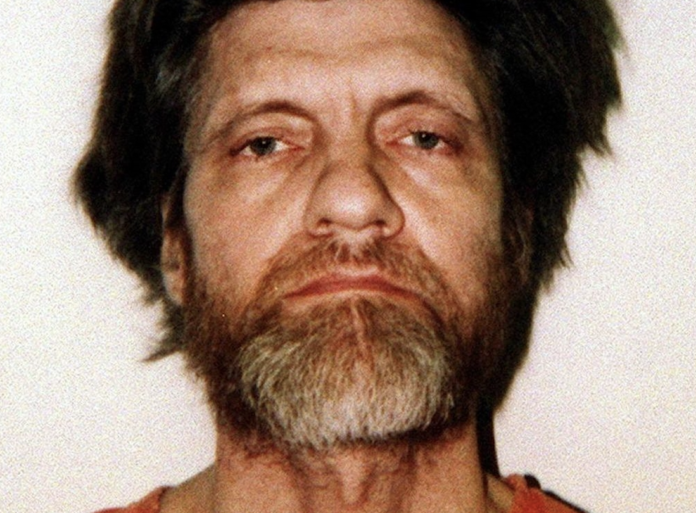“Unabomber” Ted Kaczynski, whose 17-year bombing campaign killed three people and wounded 23, was discovered dead in his cell today at the federal prison medical center in Butner, N.C. He was 81 years old.
In 1979, an FBI-led task force that included the ATF and U.S. Postal Inspection Service was formed to investigate the “UNABOM” case, code-named for the UNiversity and Airline BOMbing targets involved. The task force would grow to more than 150 full-time investigators, analysts, and others. In search of clues, the team made every possible forensic examination of recovered bomb components and studied the lives of victims in minute detail. These efforts proved of little use in identifying the bomber, who took pains to leave no forensic evidence, building his bombs essentially from “scrap” materials available almost anywhere. And the victims, investigators later learned, were chosen randomly from library research.
The big break in the case came in 1995, when the Unabomber sent federal authorities a 35,000 word essay claiming to explain his motives and views of the ills of modern society. After much debate about the wisdom of “giving in to terrorists,” FBI Director Louis Freeh and Attorney General Janet Reno approved the task force’s recommendation to publish the essay in hopes that a reader could identify the author.
After the manifesto appeared in The Washington Post, thousands of people suggested possible suspects. One stood out: David Kaczynski described his troubled brother Ted, who had grown up in Chicago, taught at the University of California at Berkeley (where two of the bombs had been placed), then lived for a time in Salt Lake City before settling permanently into the primitive 10’ x 14’ cabin that the brothers had constructed near Lincoln, Montana.
On April 3, 1996, investigators arrested Kaczynski and combed his cabin. There, they found a wealth of bomb components; 40,000 handwritten journal pages that included bomb-making experiments and descriptions of Unabomber crimes; and one live bomb, ready for mailing.
In 1998, Kaczynski pleaded guilty to all counts and was serving a life sentence. He had been transferred from the supermax prison in Florence, Colo., to Butner in 2021 for health issues.
Timeline of Unabomber Devices
- May 25, 1978: A passerby found a package, addressed and stamped, in a parking lot at the University of Illinois, Chicago Circle Campus. The package was returned to the person listed on the return address, Northwestern University Professor Buckley Crist, Jr. He did not recognize the package and called campus security. The package exploded upon opening and injured the security officer.
- May 9, 1979: A graduate student at Northwestern University is injured when he opened a box that looked like a present. It had been left in a room used by graduate students.
- November 15, 1979: American Airlines Flight 444 flying from Chicago to Washington, D.C., fills with smoke after a bomb detonates in the luggage compartment. The plane lands safely, since the bomb did not work as intended. Several passengers suffer from smoke inhalation.
- June 10, 1980: United Airlines President Percy Woods is injured when he opened a package holding a bomb encased in a book called Ice Brothers by Sloan Wilson.
- October 8, 1981: A bomb wrapped in brown paper and tied with string is discovered in the hallway of a building at the University of Utah in Salt Lake City. The bomb is safely detonated without causing injury.
- May 5, 1982: A bomb sent to the head of the computer science department at Vanderbilt University injures his secretary, after she opened it in his office.
- July 2, 1982: A package bomb left in the break room of Cory Hall at the University of California, Berkeley explodes and injures an engineering professor.
- May 15, 1985: Another bomb in Cory Hall at the University of California, Berkeley injures an engineering student.
- June 13, 1985: A suspicious package sent to Boeing Fabrication Division in Washington is safely detonated, but most of the forensic evidence was lost.
- November 15, 1985: A University of Michigan psychology professor and his assistant are injured when they opened a package containing a three-ring binder that had a bomb. The bomber included a letter asking the professor to review a student’s master thesis.
- December 11, 1985: A bomb left in the parking lot of a Sacramento computer store kills the store’s owner.
- February 20, 1987: Another bomb left in the parking lot of a Salt Lake City computer store severely injures the son of the store’s owner. A store employee sees the man leave the bomb, and that witness account helped a sketch artist create the composite sketch.
- June 22, 1993: A geneticist at the University of California is injured after opening a package that exploded in his kitchen.
- June 24, 1993: A prominent computer scientist from Yale University lost several fingers to a mailed bomb.
- December 19, 1994: An advertising executive is killed by a package bomb sent to his New Jersey home.
- April 24, 1995: A mailed bomb kills the president of the California Forestry Association in his Sacramento office.





